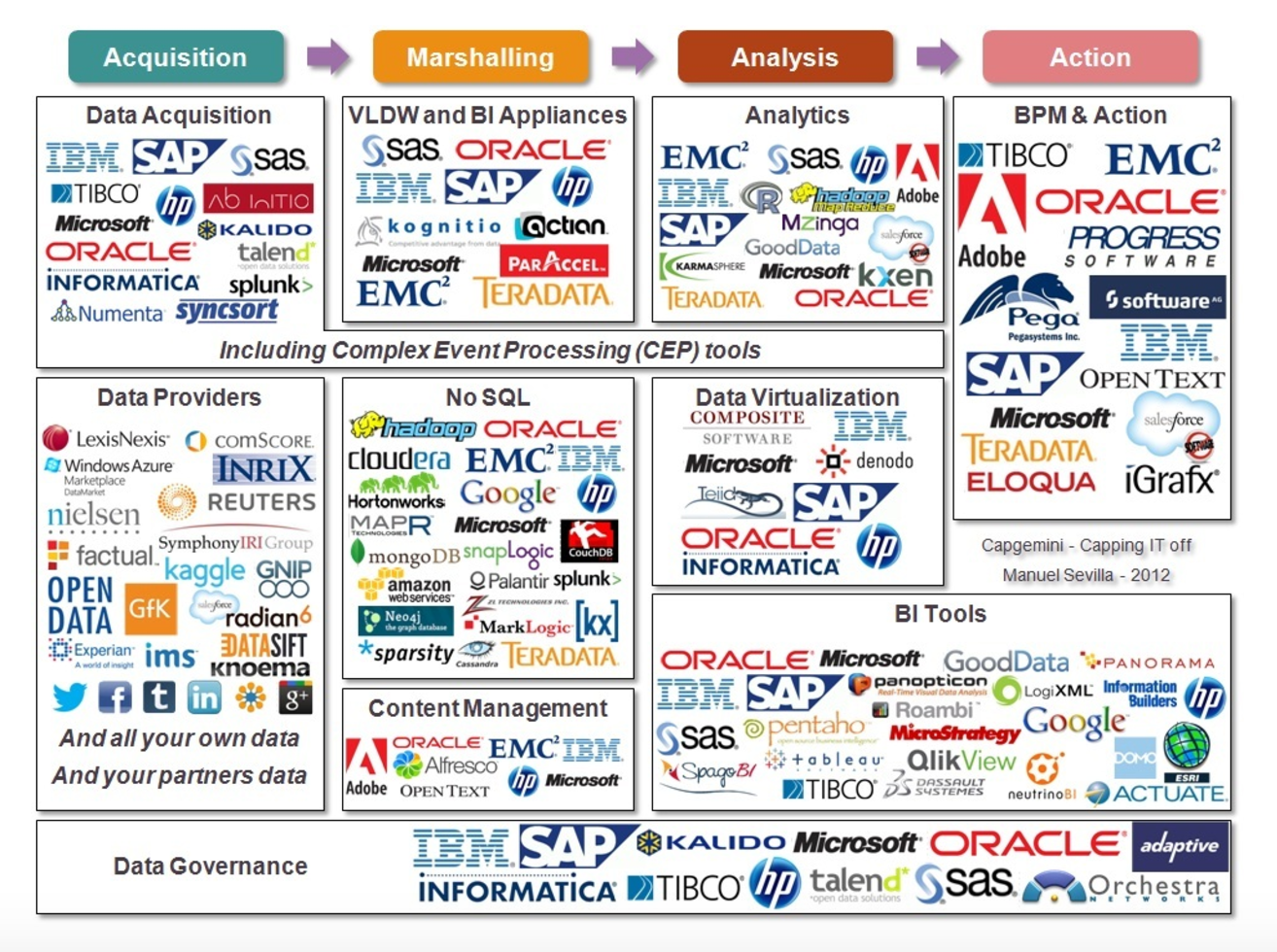You’ve connected your data highways, built the bridges, and now it’s time to take a ride. Do you have the right vehicle? Do you even have a vehicle?
Hopefully you’ve put some plan in place to extract value out of your information highway. If not, may God have mercy on your soul and the executive who decided to fund your bridge to nowhere. Most likely you know what it is you hope to get out of your “Big Data” investment, but there are a lot of unanswered questions.
At this point you’re faced with what I like to call the “Chinese Buffet” of data analytics vendors. Do you really want to eat pizza, chicken tenders, and Kung Pao chicken all in one sitting? This infographic looks a lot like a “Big Data” buffet and proves how overwhelming the vendor selection can be:
https://www.capgemini.com/blog/capping-it-off/2012/09/big-data-vendors-and-technologies-the-list
It’s no surprise why it’s so tempting to try to whittle the selection down to one vendor that does it all. You’ve convinced yourself that if you select one vendor, this decision will save money and eliminate the potential indigestion of integrating with multiple vendors from the Big Data buffet.
This can prove to be a fatal decision, especially when the solution you’re trying to build has a revenue target pinned to it. Some of you may already be familiar with the infamous Chevy El Camino. For those of you who aren’t, it’s the truck/car hybrid that’s about as appealing to look at as the mutant puppy/monkey/baby courtesy of last year’s Super Bowl commercials:
The El Camino was the ultimate utility play for people who wanted something that could haul like a truck yet still ride like a sedan. It was a one-size-fits-all solution for motorists, but unfortunately it was neither a great sedan nor a good truck.
Let’s imagine for a minute that you’re in the construction industry and competing for a bid to deliver construction materials. The job is 1 mile off-road in the mountains and the prospective client asks what kind of vehicle you’ll be using to deliver the materials. You tell the client “I’ve got an El Camino, it’s a car with a truck bed!” Your competitor submits a bid and tells the client they’ll be using a F350 Super Duty V8 4x4. Who do you think wins that bid?
How does this relate to your problem? Let’s imagine now that you’re building a data product. Many vendors in the data analytics space bill their products as a one size fits all solution, like the El Camino. Picking one vendor to do everything can leave you with an undersized and underperforming platform.
For example, your client may have asked for both an executive dashboard and unbridled access to your data so their analysts can perform ad hoc analysis. You go out and find the most whiz bang drag and drop analyst friendly chart builder. It has 80+ visualizations (half of them are 2-D and the other half are 3-D) so your client can dig in and make all the 3-D pie charts they ever wanted. The vendor also claims to have an awesome dashboard solution. You go to build your executive dashboard and it looks something like this:
https://blog.rise.global/2015/10/28/the-5-big-design-decisions-you-need-to-make-when-creating-a-personal-dashboard/
The vendor you selected gave you a great ad-hoc tool, but their data presentation/communication platform is seriously lacking. Your potential client takes one look at your platform and decides they only want to pay for access to your data at a fraction of what you hoped to charge for your product. You’re stuck in the mud with an El Camino full of data bricks.
It’s worth noting that the executive dashboard is for executives and the ad-hoc tool is for analysts. Last time I checked, executives were the ones who were responsible for cutting checks.
It’s always important to pick the right vendors for any job. Don’t expect to find a one-size-fits-all tool in the Big Data space. When building a data product, remember that the presentation of the meaning, flow, and story of your data is more important than any ad-hoc capabilities. If you fall short on effectively communicating the value of your solution, you may soon find yourself standing alone on that bridge to nowhere.
Need help finding the solution that best solves your data problems? Check out Juice's new tool, the Buyer's Guide to Analytics Solutions.



